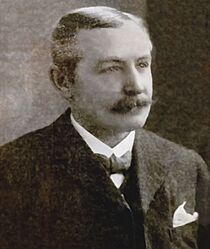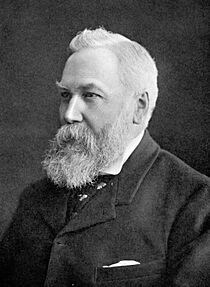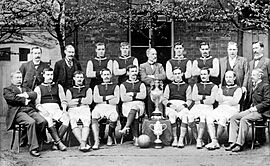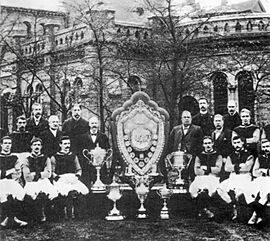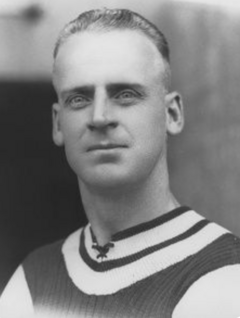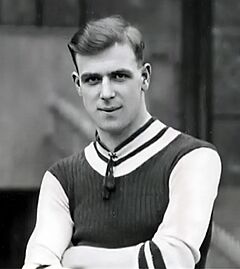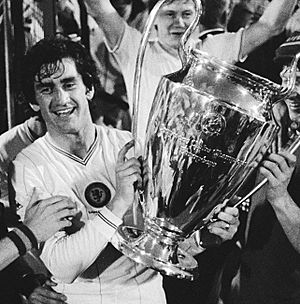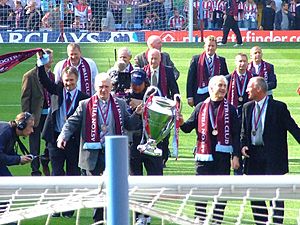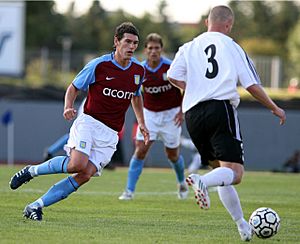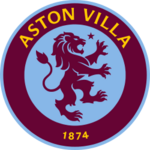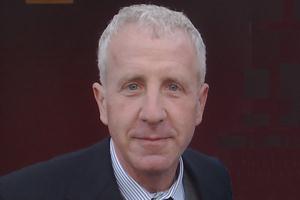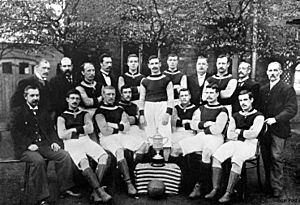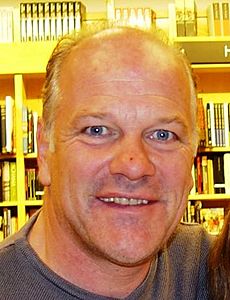Aston Villa F.C. facts for kids
 |
|||
| Full name | Aston Villa Football Club | ||
|---|---|---|---|
| Nickname(s) | The Villans The Lions |
||
| Short name | Villa | ||
| Founded | 1874 | ||
| Ground | Villa Park | ||
| Capacity | 42,918 | ||
| Owner(s) | V Sports (Nassef Sawiris, Wes Edens & Atairos) | ||
| Chairman | Nassef Sawiris | ||
| Head coach | Unai Emery | ||
| League | Premier League | ||
| 2018–19 | Championship, 5th of 24 (promoted via play-offs) | ||
|
|
|||
Aston Villa Football Club, often called Villa, is a professional football team from Aston, Birmingham, England. The club started in 1874. They play in the Premier League, which is the top football league in England. Their home stadium, Villa Park, has been their home since 1897. Aston Villa is one of England's oldest and most successful clubs. They have won the top league seven times and the FA Cup seven times. They also won the League Cup five times. In Europe, they won the European Cup (now UEFA Champions League) once and the European Super Cup once.
Aston Villa has been a top English club since the 1880s. They were pioneers of the modern passing game. This style was brought in by George Ramsay, who became the world's first professional football manager in 1886. The club also helped make football professional in 1885. A Villa director, William McGregor, started the world's first Football League in 1888.
George Ramsay helped Villa win six League Championships and six FA Cups. This made Aston Villa the most successful club in England until the 1970s. In the 1930–31 season, Villa scored 128 goals. This is still the record for the most goals in a top-flight season. However, the club faced a tough time in the mid-1930s. The 1940s and 1950s were not as successful. In the 1960s, they declined sharply. This led to Doug Ellis taking over in 1968. Villa was relegated to the third tier of English football in 1969–70.
Villa returned to the top under manager Ron Saunders in the mid-1970s. They won their seventh top-flight league title in 1980–81. They became only the fourth English club to win the European Cup in 1981–82. They also won the European Super Cup in 1982.
Aston Villa was a founding member of the Premier League in 1992. They are one of only three clubs to have founded both the Football League and the Premier League. In the 1990s and early 2000s, Villa often played in European competitions. After Martin O'Neill left, the club declined. They were relegated from the Premier League in 2015–16. After three seasons in the EFL Championship and two changes in ownership, the club returned to the Premier League in 2019. In 2024, under Unai Emery, the club qualified for the UEFA Champions League. This was their first time since 1982–83.
Villa has spent 111 seasons in the top-flight, which is the second highest of any club. They have also provided 78 players for the England national team, also the second highest. Aston Villa is currently ranked 5th in the all-time English top-flight table. They are the seventh most successful club in English football by trophies won.
Villa has a strong local rivalry with Birmingham City. Matches between them are called the Second City derby. This derby has been played since 1879. They also have a rivalry with West Bromwich Albion. These matches are known as the West Midlands derby. The club's traditional kit colours are claret shirts with sky blue sleeves, white shorts, and sky blue socks. Their traditional club badge shows a rampant lion. The club is currently owned by V Sports. This company is owned by Egyptian billionaire Nassef Sawiris, American billionaire Wes Edens, and American investment company Atairos.
Contents
Club History
How Aston Villa Started (1874−1886)
Aston Villa Football Club was formed on November 21, 1874. It was started by members of the Villa Cross Wesleyan Chapel in Handsworth, which is now part of Birmingham. The four founders were Jack Hughes, Frederick Matthews, Walter Price, and William Scattergood. They were part of the chapel's cricket team and wanted to stay fit in winter. Since there were no local football teams, Aston Villa's first match was against the Aston Brook St Mary's Rugby team. Villa had to play the first half under Rugby rules and the second half under Association rules. Villa won their first game 1–0.
The club's future changed in 1876 when a young Scotsman named George Ramsay saw them playing in Aston Park. He was asked to join in, and everyone was amazed by his skills. They had never seen such good ball control. After the game, the Villa players asked him to join and become their captain. News spread about Ramsay's talent, and spectators came to watch "Scotty." He also took charge of training. Ramsay said the club's old style was "a dash at the man and a big kick at the ball."
Ramsay had learned from the Scottish club Queen's Park. They were known for "combination football" in Glasgow. The passing game he brought to Villa was new for an English club in the late 1870s. Villa became one of the best teams in the Midlands. They won their first trophy, the Birmingham Senior Cup, in 1880. The club won this trophy nine times in the next 12 seasons.
The Golden Age (1886–1914)

After football became professional in 1885, the club needed a full-time paid manager. In June 1886, an advert was placed in the newspaper. It asked for a manager for Aston Villa Football Club, offering £100 per year. Villa received 150 applications. But George Ramsay, with his strong connection to the club, was the clear choice. On June 26, 1886, Aston Villa appointed what is called the world's first professional football manager.
The next season, Aston Villa became famous across the country. They were the first Midlands team to win the FA Cup in 1887. Villa's captain, Archie Hunter, became one of the first well-known players. He was the first player to score in every round of the FA Cup. Aston Villa was one of the 12 teams in the first English Football League in 1888. One of the club's directors, William McGregor, founded the league.
After football became professional, clubs needed regular money to pay players. Friendly matches were often cancelled. McGregor acted after five Villa matches were cancelled in a row. In March 1888, he wrote to his club and others. He suggested a league competition to guarantee matches each season. After two meetings, the world's first Football League season began in September 1888. It had 12 clubs from the Midlands and north of England.
Even though Villa helped start the league, they had not won it by 1893. Villa Committee Member Frederick Rinder led a meeting in February 1893. This meeting removed the old committee. All 14 members resigned and were replaced by five new members led by Rinder. He criticized the old board for allowing bad discipline and players drinking. On the field, manager George Ramsay built a team known for its short, quick passing. Villa won its first league title in 1893–94. The next season, they won their second FA Cup in 1894–95. This was followed by two more League titles in 1895–96 and 1896–97.
Aston Villa became the most successful English club of the Victorian era. They won five League titles and three FA Cups by 1901. Villa's captain during this time was John Devey. He played well with fast winger Charlie Athersmith. In defense, James Cowan was a strong Scottish player. In 1897, the year Villa won The Double, they moved to their current home, the Aston Lower Grounds. Fans called it "Villa Park," and the name stuck.
Success continued into the Edwardian era. Villa won the FA Cup for the fourth time in 1904–05. They won their sixth league title in 1909–10. Another FA Cup win came in 1913, just before the First World War. The club almost won a second Double, finishing second in the league. Star players included Howard Spencer, a skilled defender who captained both Villa and England. The goal scorers Joe Bache and Harry Hampton scored 382 goals together for Villa.
Challenges and Relegation (1920–1939)
In January 1920, Billy Walker scored twice in his first game for Villa. This was a 2–1 FA Cup win against QPR. The club won the FA Cup for the sixth time that season. Walker became Villa's star player of the 1920s. He scored a record 244 goals in 531 games. He also captained Villa and England. George Ramsay retired in 1926 at 71. His replacement, Billy Smith, could not continue Ramsay's success. Other clubs, like Arsenal, had caught up. Villa finished second to Arsenal in the league in 1930–31 and 1932–33.
Even without winning the league, Villa Park fans enjoyed attacking football. The 128 goals scored in 1930–31 is still the all-time top-flight record. A remarkable 49 of those goals were scored by Tom 'Pongo' Waring. Winger Eric Houghton added another 30 goals.
The club hired Jimmy McMullan as manager in 1934. This was a bad move. Villa was relegated for the first time in 1935–36, after 48 years in the top league. Villa struggled because their defense was poor. They let in 110 goals in 42 games. Seven of these came from Arsenal's Ted Drake in a famous 1–7 loss at Villa Park. The club bought seven new players and spent a lot of money (£35,500) to stay in the top league. But they could not avoid relegation. Aston Villa, a famous and successful club, was relegated in 1936.
After relegation, the Villa board brought back former chairman Fred Rinder. He said, "Villa have been a great club, are still a great club, and always will be a great club." He criticized the board for ignoring the reserve team. He felt they relied too much on buying expensive players. Rinder believed this changed the club's culture and style. It also led to bad discipline and relegation. Rinder's first action was to hire Jimmy Hogan as manager from Austria. Within two seasons, Hogan led Villa back to the top league as Second Division champions. He taught attractive, free-flowing football. Hogan said, "football was like a Viennese waltz, a rhapsody. One-two-three, one-two-three, pass-move-pass, pass-move-pass." Sadly, Second World War stopped Hogan's plan to bring Villa back to the top.
Tough Times and Comeback (1945–1974)
Like all English clubs, Villa lost seven seasons to World War II. The war also ended some players' careers early. Huge crowds came to Villa Park after the war. A record 76,588 people watched the FA Cup quarter-final between Villa and Derby County in March 1946. This is still the highest attendance at Villa Park. The team was rebuilt by former player Alex Massie in the 1940s. Star players included Harry Parkes, Trevor Ford, and Johnny Dixon. However, the club only finished in the middle of the league table in the 1940s and 1950s. They never finished higher than 6th place. The board faced more and more criticism. The 1953 AGM (Annual General Meeting) was described as "the longest and liveliest Villa meeting." Fans and shareholders criticized the club for not developing young players, and for poor recruitment and training. When Danny Blanchflower asked to leave in 1954, he said the club "had grown fat and lazy on its old traditions."
Despite almost being relegated the season before, Aston Villa won their first trophy in 37 years in 1956–57. Another former Villa player, Eric Houghton, led the club to a record seventh FA Cup Final win. They beat Manchester United 2–1, with Peter McParland scoring both goals. The team still struggled in the league. Eric Houghton was sacked in December 1958. His replacement, Joe Mercer, could not stop the club from being relegated for only the second time in 1958–59. However, under Mercer, Villa returned to the top league in 1960 as Second Division Champions. They had a talented young team known as 'Mercer's Minors'. The next season, Aston Villa became the first team to win the Football League Cup. England striker Gerry Hitchens scored an impressive 42 goals in 1960–61.
Hitchens' goals caught the eye of Italian club Inter Milan. They offered him a lot of money to sign. He was sold for £85,000 in the summer of 1961. His replacement, Derek Dougan, was not as successful, and Villa declined. Mercer's forced retirement in July 1964, due to a stroke, started a period of deep trouble. England's most successful club had not kept up with modern football. Three of the five directors were over 70. The club had ignored its scouting and coaching. Its finances were in a bad state. This led to the club selling its top striker Tony Hateley to Chelsea for £100,000 in October 1966. Without his goals, Villa was relegated for the third time in 1967 under manager Dick Taylor. The board even sold the club's training ground near Villa Park for housing. This left the team training on borrowed pitches from local factory teams.
The next season, fans demanded the board resign. Villa finished 16th in the Second Division. With growing debts and Villa at the bottom of Division Two, the board sacked Tommy Cummings (the manager who replaced Taylor). Within weeks, the entire board resigned due to huge pressure from fans. After much talk, London financier Pat Matthews bought control of the club. He brought in Doug Ellis as chairman in December 1968. Ellis remembered that "you could write your name in the dust, window frames were rotting, the smell of failure and imminent financial ruin hung in the air." One of their first actions was to raise £205,835 in shares, which cleared the club's debts. Doug Ellis's first manager was Tommy Docherty. After some early success, he was sacked after 13 months with the club at the bottom of the Second Division. His replacement was former club captain and reserve team manager Vic Crowe. He could not stop Villa from being relegated to the Third Division for the first time in 1969–70.
The next season, Villa surprised everyone. They beat Manchester United in the semi-final to reach the 1971 League Cup Final. The team played well but lost to two late Tottenham Hotspur goals. There was new hope at Villa Park. The club was promoted to the Second Division as champions. Average attendances were 30,000, and they earned a record 70 points in the 1971–72 season. Off the field, the board bought the new 20-acre Bodymoor Heath Training Ground in December 1971. This was to improve the club's youth development and coaching.
Back to the Top (1974–1992)
After finishing 14th in the Second Division, Vic Crowe was replaced by Ron Saunders in August 1974. Saunders was very focused on fitness. His tough management style worked well. The club won the League Cup the next season. By the end of the 1974–75 season, he had taken Aston Villa back into the First Division and into Europe. One player who stayed with Villa through all the ups and downs was fan-favorite Charlie Aitkin. He played 659 games at left back for the club between 1959 and 1976. This makes him Villa's all-time record appearance holder.
Aston Villa was back among the top teams. Saunders continued to build a winning team. They finished 4th in the league and won another League Cup in 1976–77. They had a strong attacking duo in Brian Little and Andy Gray. Gray became the first player to win both the PFA Young Player of the Year and PFA Players' Player of the Year in the same season.
The 1970s saw some disagreements on the board at Villa Park. Ron Saunders had a difficult relationship with Doug Ellis. Saunders felt Ellis interfered too much in football matters. Over time, Ellis became isolated on the board as other directors supported Saunders. He was removed as chairman in 1975, replaced by Sir William Dugdale. Ellis stayed on the board until 1979. He left after a long power struggle with majority shareholder Ron Bendall. With Ellis gone, Saunders had full control as manager.
Villa won their seventh top-flight league title in 1980–81. Players like Gordon Cowans, Tony Morley, and captain Dennis Mortimer led the club to its first top-flight title in 71 years. Amazingly, they did it using only 14 players, with seven playing every game. Villa's Birmingham-born forward Gary Shaw was named 1980-1981 PFA Young Player of the Year.
To everyone's surprise, Ron Saunders quit halfway through the 1981–82 season. Villa was in the European Cup quarter-final. Saunders was frustrated by the lack of money to strengthen the team. He also disagreed with chairman Ron Bendall about his contract. His assistant manager, Tony Barton, took over. Barton led the club to a 1–0 victory over Bayern Munich in the European Cup final in Rotterdam. Peter Withe scored the goal in the 67th minute. Ten minutes into the final, Villa's main goalkeeper, Jimmy Rimmer, was injured. Young substitute keeper Nigel Spink had to play, having only played one first-team game before. Spink played brilliantly, keeping a clean sheet. He helped Villa become only the fourth English club to win the European Cup.
The next season, Villa's defense of the European Cup ended in a quarter-final loss to Juventus. But Villa won the European Super Cup. They beat Barcelona 3–1 over two games. This was a high point. Villa's fortunes then dropped sharply for most of the 1980s. Doug Ellis returned as chairman and majority shareholder in November 1982. The club had big debts. There were also questions about financial issues related to building the North Stand at Villa Park from 1980 to 1982. The work cost £1.3 million. An internal investigation found £700,000 of the bills were missing. A later report found "serious breaches of recommended codes of practice." Ellis immediately tried to cut the club's costs. He told players they needed pay cuts and told manager Tony Barton to reduce the squad. Saunders' team was broken up and not replaced well. This led to the club being relegated in 1987, just five years after winning the European Cup.
However, Villa quickly bounced back. They were promoted the next year under Graham Taylor. They finished second in the top league in the 1989–90 season. This was with a great team including Paul McGrath, Tony Daley, and David Platt. After this success, Graham Taylor became the England manager in 1990.
Premier League Years (1992–2016)
Villa was one of the founding members of the Premier League in 1992. They are one of only three clubs to have founded both the Football League in 1888 and the Premier League. The others are Blackburn Rovers and Everton. Villa finished second to Manchester United in the first Premier League season under manager Ron Atkinson. His team won the League Cup in 1994. They beat Manchester United 3–1 in the final, with goals from Dalian Atkinson and Dean Saunders. But the team struggled in the league. Atkinson was replaced by former Villa striker Brian Little in November 1994. Little built a young team with players like Gareth Southgate, Steve Staunton, Ian Taylor, and Dwight Yorke. He led the club to its fifth League Cup win in 1996, beating Leeds United 3–0 at Wembley. Villa finished fourth in the league that season, and fifth the next.
After a dip in form, Doug Ellis sacked Little. He replaced him with another former Villa player, John Gregory, in February 1998. One of his first games was the UEFA Cup quarter-final against Atlético Madrid. Villa lost on away goals. In the summer of 1998, Yorke was sold to Manchester United for £12.6 million. Gregory managed four top-eight finishes in the league. He took the club to an FA Cup final in 2000. His team included David James, Dion Dublin, Paul Merson, and Gareth Barry. But he could not build a team to challenge for Champions League spots. At the end of the season, Villa's captain Gareth Southgate asked to leave. He said, "if I am to achieve in my career, it is time to move on." Gregory was frustrated by the lack of money for the team. He publicly accused Ellis of being "stuck in a time warp." Their relationship remained difficult until Gregory resigned in January 2002.
Ellis appointed Graham Taylor for a second time in February 2002. But a 16th-place finish led to his replacement by David O'Leary in June 2003. After finishing sixth in his first season, Villa finished 10th and 16th. O'Leary left in the summer of 2006.
After 23 years as chairman and biggest shareholder, Ellis sold his stake in Aston Villa due to poor health at 82. American businessman Randy Lerner, who owned the NFL team Cleveland Browns, bought the club in September 2006. Lerner's arrival and manager Martin O'Neill brought new hope to Villa Park. Many changes happened, including a new badge and investment in modern facilities at Bodymoor Heath Training Ground. There was also significant investment in the team in summer 2007. The first cup final of the Lerner era was in 2010. Villa lost 2–1 in the League Cup Final.
Just five days before the start of the 2010–11 season, O'Neill resigned as manager. This was despite three straight 6th-place finishes. He was frustrated by the lack of money for the squad after selling star players Gareth Barry, James Milner, and Ashley Young. His replacement, Gérard Houllier, stepped down due to ill-health in September 2011. He was replaced by Birmingham City manager Alex McLeish, despite fan protests. McLeish's contract ended after the 2011–12 season, as Villa finished 16th. He was replaced by Paul Lambert.
In February 2012, the club announced a financial loss of £53.9 million. Lerner put the club up for sale three months later. With Lerner still in charge but unwilling to spend after the 2008 stock market crash, the club was not competitive for several seasons. In the 2014–15 season, Lambert was sacked in February 2015. The team had only scored 12 goals in the first 25 league games, the lowest in Premier League history. Tim Sherwood took over. He helped the club avoid relegation and led them to the 2015 FA Cup Final. However, the club sold two star players, Christian Benteke and captain Fabian Delph, in the summer. They were not replaced well. Villa struggled in the 2015–16 season. Sherwood was sacked after six straight defeats. He was replaced by Rémi Garde. Garde left after just five months, with Villa at the bottom of the table. His time included a club-record 19-game winless streak. The club was relegated at the end of the season, ending their 29-year stay in the top league.
From Championship to Champions League (2016–Present)
In June 2016, Chinese businessman Tony Xia bought the club for £76 million. Former Chelsea boss Roberto Di Matteo became the new manager. But he was sacked after only 12 games due to a bad start. He was replaced by former Birmingham manager Steve Bruce. Bruce led the team to finish fourth in the 2017–18 season. But they lost in the 2018 EFL Championship play-off final to Fulham.
After failing to get promoted to the Premier League, the club faced big financial problems. With rumors of administration (financial collapse), Xia looked to sell the club. On July 20, 2018, it was announced that the NSWE Group would invest in the club. This group included Egyptian billionaire Nassef Sawiris and American billionaire Wes Edens. They bought a controlling 55% stake in the club. Sawiris became the club chairman, and Christian Purslow was appointed CEO.
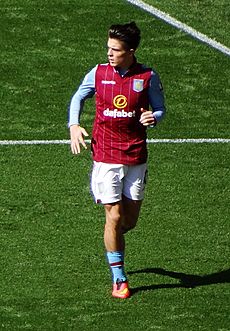
In October 2018, Bruce was sacked after winning only one game in nine. He was replaced by Brentford manager and lifelong Villa fan Dean Smith. Smith led the team to fifth place and reached the playoffs again. This was helped by a club-record 10-game winning streak in the league. They reached the 2019 EFL Championship play-off final and beat Derby County 2–1. This earned them promotion back to the Premier League after three years.
Before Villa's Premier League return, NSWE bought out Recon Group's shares. This meant Xia no longer owned any part of the club. Villa's first season back in the Premier League saw many changes to the squad. Twelve players were signed in the summer. The team fought against relegation for most of the season. But they stayed up on the final day with a 17th-place finish. In Villa's second Premier League season, Smith led them to an 11th-place finish. But he could not convince star player and captain Jack Grealish to stay. Manchester City's British-record £100 million offer triggered his release clause. After a poor start to the 2021–22 season, with seven losses in the first 11 games, Dean Smith was fired.
Aston Villa appointed former Liverpool and England captain Steven Gerrard as head coach on November 11, 2021. After a poor start to the 2022–23 season, with only two wins and seven goals in their first 11 games, Gerrard was sacked in October 2022. He was replaced by four-time Europa League-winning Spanish manager Unai Emery. Emery led Villa to 7th place and qualification for the Europa Conference League in his first season. In the 2023–24 season, Emery led the club to the Conference League semi-finals. They were knocked out by Olympiacos. They also finished 4th in the league, securing a spot in the UEFA Champions League for the first time since 1982–83.
Club Colours and Badge
|
|
| Villa's proposed kit of 1886 |
Aston Villa's club colours are a claret shirt with sky blue sleeves, white shorts with claret and blue trim, and sky blue socks with claret and white trim. They were the first team to wear claret and blue. When the club started, Villa's colours were royal blue caps and stockings, royal blue and scarlet striped jerseys, and white shorts. One club rule said, "no member can take part in a match without wearing the above uniform." For a few years (1877–79), the team wore different kits, including all white, blue and black, red and blue, or plain green. By 1880, black jerseys with a Scottish Lion Rampant on the chest were introduced by Villa's Scottish leaders William McGregor and George Ramsay. This was the main kit for six years. On November 8, 1886, the club's official notes said:
(i) Proposed and seconded that the colours be chocolate and sky blue shirts and that we order two dozen.
(ii) Proposed and seconded that Mr McGregor be requested to supply them at the lowest quotation.
The chocolate colour later became claret. No one is completely sure why claret and blue became the club's chosen colours. Several other football teams also play in claret and blue, such as West Ham United, Burnley, Scunthorpe United, and Turkish club Trabzonspor. Crystal Palace also wore Villa's colours until the 1970s.
A new badge was shown in May 2007 for the 2007–08 season. The new badge includes a star to show the European Cup win in 1982. It has a light blue background behind Villa's 'lion rampant'. The traditional motto "Prepared" stayed on the badge. The name Aston Villa was shortened to AVFC, with FC removed from the previous badge. The lion is now one solid image, not broken up like older lions. Randy Lerner asked fans to help design the new badge.
On April 6, 2016, the club confirmed a new badge for the 2016–17 season after asking fan groups for ideas. The lion in the new badge has claws. The word "Prepared" was removed to make the lion and club initials bigger. In November 2022, after a fan vote, the club announced a new badge for the next season. The club president of business operations, Chris Heck, later clarified that this new badge would only be used on kits and training wear. The existing badge would still be used for everything else. In May 2024, the club went back to a shield-shaped badge.
Kit Manufacturers and Sponsors
Here are tables showing the companies that made Villa's kits and sponsored their shirts:
| Years | Kit manufacturer | Kit sponsor | Sleeve sponsor | Back sponsor |
|---|---|---|---|---|
| 1974–1981 | Umbro | None | None | None |
| 1981–1982 | Le Coq Sportif | |||
| 1982–1983 | Davenports Brewery | |||
| 1983–1984 | None | |||
| 1984–1985 | Mita Copiers | |||
| 1985–1987 | Henson | |||
| 1987–1990 | Hummel | |||
| 1990–1993 | Umbro | |||
| 1993–1995 | Asics | Müller | ||
| 1995–1998 | Reebok | AST Computers | ||
| 1998–2000 | LDV Vans | |||
| 2000–2002 | Diadora | NTL | ||
| 2002–2004 | Rover | |||
| 2004–2006 | Hummel | DWS Investments | ||
| 2006–2007 | 32Red | |||
| 2007–2008 | Nike | |||
| 2008–2010 | Acorns Children's Hospice | |||
| 2010–2011 | FxPro | |||
| 2011–2012 | Genting Casinos | |||
| 2012–2013 | Macron | |||
| 2013–2015 | Dafabet | |||
| 2015–2016 | Intuit Quickbooks | |||
| 2016–2017 | Under Armour | |||
| 2017–2018 | Unibet | Recon Group | ||
| 2018–2019 | Luke 1977 | 32Red | None | |
| 2019–2020 | Kappa | W88 | BR88 | |
| 2020–2021 | Cazoo | LT.COM | ||
| 2021–2022 | OB Sports | |||
| 2022–2023 | Castore | Kaiyun Sports | ||
| 2023–2024 | BK8 | Trade Nation | ||
| 2024– | Adidas | Betano | Black Sabbath (League Cup) |
Aston Villa's kits were made by local companies until 1974. Then, Umbro became the first kit supplier to have its logo on a Villa shirt. Aston Villa's first shirt sponsor was Davenports Breweries in the 1982–83 season. For the 2008–09 and 2009–10 seasons, Aston Villa did not have a commercial sponsor. Instead, they advertised the charity Acorns Children's Hospice. This was the first deal of its kind in Premier League history. The partnership continued until 2010 when a commercial sponsor took over. Acorns became the club's Official Charity Partner. A shirt sleeve sponsor was used for the first time in the 2019–20 season, with BR88 displayed.
Villa Park: The Home Stadium
Aston Villa's current home is Villa Park. Before this, the team played at Aston Park (1874–1876) and Wellington Road (1876–1897). Villa Park is the biggest football stadium in the English Midlands. It is also the eighth largest stadium in England. It has hosted 16 England international matches for the senior team. The first was in 1899, and the most recent was in 2005. This means it was the first English ground to host international football in three different centuries. Villa Park is the most used stadium for FA Cup semi-finals, having hosted 55 of them. In 2022, the club announced plans to rebuild the North Stand and part of the Trinity Road stand. This will increase the stadium's capacity to over 50,000.
The current training ground is at Bodymoor Heath. It is near Kingsbury in north Warwickshire. Former chairman Doug Ellis bought the land from a local farmer in the early 1970s. Bodymoor Heath was very modern in the 1970s. But by the late 1990s, the facilities started to look old. In November 2005, Ellis and Aston Villa plc announced a £13 million redevelopment of Bodymoor in two stages. The new training ground was officially opened on May 6, 2007. The manager Martin O'Neill, team captain Gareth Barry, and 1982 European Cup winning captain Dennis Mortimer were there. The Aston Villa squad moved in for the 2007–08 season.
On August 6, 2014, it was announced that Villa Park would appear in the FIFA video game series starting with FIFA 15. All other Premier League stadiums were also fully licensed from this game onwards.
Club Ownership
The first shares in the club were sold in the late 1800s. This was because of new laws for professional football teams. FA teams had to sell shares to investors. This helped teams trade players without involving the FA directly. This continued for much of the 20th century. Then, Doug Ellis started buying many shares in the 1960s. He was chairman and a major shareholder of "Aston Villa F.C." from 1968 to 1975. He was the majority shareholder from 1982 to 2006. The club was listed on the London Stock Exchange (LSE) in 1996. The share price changed a lot in the ten years after that. In 2006, it was announced that several groups and individuals were thinking about buying Aston Villa.
On August 14, 2006, it was confirmed that Randy Lerner had agreed to buy Aston Villa for £62.6 million. Lerner was also the owner of the National Football League's Cleveland Browns. Lerner took full control on September 18. Ellis and his board were replaced by a new board chosen by Lerner on September 19, 2006. Lerner made himself chairman of the club. Charles Krulak became a non-executive director. Ellis was given the honorary title of Chairman Emeritus. Lerner put the club up for sale in May 2014, valuing it at about £200 million.
On May 18, 2016, Randy Lerner agreed to sell Aston Villa to Recon Group. This group was owned by Chinese businessman Tony Xia. The sale was completed on June 14, 2016, for a reported £76 million. The Football League approved it. After spending a lot of money and failing to get promoted to the Premier League in the 2017–18 Championship playoff final, the club faced financial problems. With rumors that Villa might go into administration, Xia started talks to sell the club in June 2018.
On July 20, 2018, it was announced that V Sports (then called NSWE Group) would invest in the club. This group included Egyptian billionaire Nassef Sawiris and American billionaire Wes Edens. They bought a controlling 55% stake in the club. Sawiris became the club chairman. On August 9, 2019, after Villa's promotion to the Premier League, it was revealed that Xia's remaining shares had been bought out. Xia no longer owned any part of the club.
On December 15, 2023, Aston Villa announced that Atairos, an American investment firm backed by Comcast, would invest in V Sports. V Sports is the main company that owns the club. This agreement meant Atairos got about a 20% stake in V Sports. It valued Villa at over £500 million. The deal with Atairos was finalized on April 12, 2024. Atairos CEO and former Comcast CFO Michael Angelakis joined Villa's board of directors.
Community Work
Aston Villa has a special relationship with the Acorns Children's Hospice charity. This was a new idea in English football. For the first time in the Premier League, Aston Villa gave the front of its kit shirts to Acorns Hospice. This space is usually for high-paying sponsors. This helped the charity get more attention and raise more money. Besides the shirt sponsorship, the club has paid for hospice care for the charity. Players also visit hospice locations regularly.
In September 2010, Aston Villa started a project at Villa Park called Villa Midlands Food (VMF). The club planned to train students in hospitality and events for two years, working with Birmingham City Council. The club opened a restaurant in the Trinity Road Stand. It was staffed by 12 students from within 10 miles of Villa Park. Most of the food served was from local sources.
Aston Villa Foundation
In 2016, Aston Villa created a registered charity called the Aston Villa Foundation. The charity's goal is to do Aston Villa's social responsibility work. Working with local and national partners, the Foundation runs projects. These include football in the community, disability support, health and wellbeing, education, and community relations.
In May 2021, Prince William, Duke of Cambridge met with members of the Foundation at Aston Villa's Bodymoor Heath Training Ground. This was after the Foundation provided 1000 hot meals a week to local groups during the COVID-19 pandemic in the United Kingdom. They also let a local NHS Trust use Villa Park's facilities.
Supporters and Rivalries
Aston Villa has many fans. They come from all over the Midlands and beyond. There are supporters' clubs all over the world. Former Villa chief executive Richard Fitzgerald said that 98% of supporters are white. When Randy Lerner took over, they aimed to get more support from ethnic minorities. Several groups were set up to help the local community, like Aston Pride. A "Villa in the Community" program was also started to encourage young people in the area to support the club. The new owners also did surveys to get fans' opinions and involve them in decisions. Meetings happen every three months where fans are invited to ask questions to the board. In 2011, the club supported a fan idea for an official song to improve the atmosphere at Villa Park. The song "The Bells Are Ringing" is played before games.
Like many English football clubs, Aston Villa has had some hooligan groups linked to it. These included Villa Youth, Steamers, Villa Hardcore, and the C-Crew. The C-Crew was very active in the 1970s and 1980s. In 2004, some Villa groups were involved in a fight with QPR fans outside Villa Park, where a steward died. As seen across English football, these hooligan groups are now much smaller. The main groups of supporters are now found in many local and international supporters' clubs. This includes the Official Aston Villa Supporters Club, which has smaller regional and international sections. There were several independent supporters clubs when Doug Ellis was in charge. Most of these stopped after he retired. The supporter group My Old Man Said was formed to protect Villa supporters' rights. This happened because Villa fans protested against the club hiring Alex McLeish. The club's supporters also publish fanzines like Heroes and Villains and The Holy Trinity.
Aston Villa's biggest rivals are Birmingham City. Games between them are called the Second City Derby. Historically, West Bromwich Albion have also been strong rivals. A fan survey in 2003 showed this. The two teams played in three FA Cup finals in the late 1800s. Villa also has less intense local rivalries with Wolverhampton Wanderers and Coventry City. When West Brom and Birmingham City were relegated to the Football League Championship in the 2005–06 season, Villa was the only Midlands club in the Premier League at the start of the 2006–07 season. The closest opposing team Villa faced that season was Sheffield United, who played 62 miles away. For the 2010–11 Premier League season, West Bromwich Albion was promoted. This meant Aston Villa, Wolverhampton Wanderers, and Birmingham City were all in the Premier League together. This was the first time the "West Midlands' Big Four" clubs were in the Premier League at the same time. It was also the first time they were together in the top league since the 1983–84 season. Birmingham was relegated at the end of the 2010–11 season, ending this period.
The rivalry with Birmingham City started again in 2016–17 when Aston Villa was relegated from the Premier League. West Brom joined them two years later. But Villa won promotion back to the Premier League in 2019.
In 2024, a supporter group called 1897 Group was formed. It is named after the year the club first used Villa Park as its home stadium. Their goal is to make the atmosphere at Villa Park louder and more visible during matches. After meeting with club officials, the 1897 Group was given a section of seats in the Doug Ellis Stand for a Premier League match against A.F.C. Bournemouth. This started the group's physical presence at games. The 1897 Group also helps organize flag and tifo displays in Villa Park's Holte End stand and other parts of the stadium for some home matches. They also organize and promote Villa fan marches. In these, Villa supporters gather at a specific point in the town or city where Villa is playing and walk together to the stadium.
Club Records and Statistics
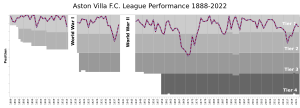
The 2024–25 season is Aston Villa's 111th season in the top tier of English football. Only Everton has spent longer in the top flight, with 122 seasons. This makes Aston Villa versus Everton the most-played match in English top-flight football. Aston Villa was relegated from the top tier in 2016. They had played in every Premier League season since it started in 1992–93. But they were promoted back in 2018–19. They are ninth in the All-time Premier League table. They have the fifth highest number of major trophies (20) won by an English club.
Aston Villa holds the record for the most league goals scored by any team in the English top flight. They scored 128 goals in the 1930–31 season. This is one more than Arsenal, who won the league that season, with Villa finishing second. Villa forward Archie Hunter was the first player to score in every round of the FA Cup during Villa's winning campaign in 1887. Villa's longest unbeaten home run in the FA Cup lasted 13 years and 19 games, from 1888 to 1901.
Aston Villa is one of six English teams to have won the European Cup. They did this on May 26, 1982, in Rotterdam. They beat Bayern Munich 1–0 with Peter Withe's goal. As of 2024, Aston Villa is only behind Tottenham Hotspur (79) for providing the most England international players. 77 Villa players have played for England since 1882.
Club Honours
Aston Villa Football Club has won European and domestic league trophies. The club's last English trophy was in 1996 when they won the League Cup. Most recently, they won the 2001 UEFA Intertoto Cup.
Domestic Trophies
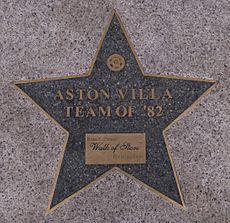
League
- First Division / Premier League (top league)
- Champions (7): 1893–94, 1895–96, 1896–97, 1898–99, 1899–1900, 1909–10, 1980–81
- Runners-up (10): 1888–89, 1902–03, 1907–08, 1910–11, 1912–13, 1913–14, 1930–31, 1932–33, 1989–90, 1992–93
- Second Division / Championship (second league)
- Champions: 1937–38, 1959–60
- Runners-up: 1974–75, 1987–88
- Play-off winners: 2019
- Third Division (third league)
- Champions: 1971–72
Cups
- FA Cup
- Winners (7): 1886–87, 1894–95, 1896–97, 1904–05, 1912–13, 1919–20, 1956–57
- Runners–up (4): 1891–92, 1923–24, 1999–2000, 2014–15
- Football League Cup / EFL Cup
- Winners (5): 1960–61, 1974–75, 1976–77, 1993–94, 1995–96
- Runners-up (4): 1962–63, 1970–71, 2009–10, 2019–20
- FA Charity Shield
- Winners: 1981
- Sheriff of London Charity Shield
- Winners: 1899, 1901
European Trophies
- European Cup
- Winners: 1981–82
- European Super Cup
- Winners: 1982
- Intertoto Cup
- Winners: 2001
- 3rd Round Winners (1 of 11) & Overall Joint Runners-Up (1 of 3): 2008
Aston Villa Players
First-Team Squad
, This is the official first team squad, including young players who have played in a league game.
|
|
Players on Loan
|
|
Under-21s and Academy Players
, Players under 21 who are in the senior squad or have played for the senior team are listed above. This list includes all academy players who have been part of a senior matchday squad.
|
|
Club Captains
Since the club started in 1874, 43 players have been Aston Villa's club captain. John Devey, who was captain from 1891 to 1898, is their most successful captain. He led Villa to five league titles and two FA Cup wins during the club's 'Golden Age'. The current captain is Scotland international John McGinn.
|
|
|
Famous Players
Many players have been famous throughout Aston Villa's history. These players are recognized in different ways, like Halls of Fame and Player of the Year awards. Aston Villa has had several players who played for only one club, including Billy Walker. In 1998, to celebrate 100 seasons of League football, The Football League made a list called the Football League 100 Legends. Seven players on this list played for Villa: Danny Blanchflower, Trevor Ford, Archie Hunter, Sam Hardy, Paul McGrath, Clem Stephenson, and Peter Schmeichel. Schmeichel was later added to the Premier League Hall of Fame in 2022. Former Villa captain and coach John Terry was inducted in 2024.
Aston Villa has had many players who were successful internationally while at the club. Paul McGrath and Steve Staunton (Republic of Ireland), and Olof Mellberg (Sweden) all captained their national teams in the 1990, 2002, and 2006 World Cups. McGrath played nine times at the World Cup while at Aston Villa, a record for an active Villa player. Emiliano Martínez has earned all his senior Argentina caps while playing for Aston Villa, starting in June 2021. He is currently the most decorated international player for Aston Villa. He won the 2021 Copa América, the 2022 Finalissima, the 2022 FIFA World Cup, and the 2024 Copa América. He also won the Golden Glove awards at the 2021 and 2024 Copa América and the 2022 World Cup. He was named the Best FIFA Goalkeeper and won the Yashin Trophy twice between 2022 and 2024.
Three Aston Villa players have won the PFA Players' Player of the Year award. In 1977, Andy Gray won the award. In 1990, it was given to David Platt. Paul McGrath won it in 1993. The PFA Young Player of the Year award, for players under 23, has been given to four Villa players: Andy Gray in 1977; Gary Shaw in 1981; Ashley Young in 2009; and James Milner in 2010. Ollie Watkins was named in the 2023/24 PFA Team of the Year. He scored 19 goals and made 13 assists that season.
The National Football Museum in Preston, Lancashire has the English Football Hall of Fame. It includes one Villa team, five Villa players, and one manager. The 1982 European Cup-winning team was added to the Hall of Fame in October 2011. Former Aston Villa players in the Hall of Fame are Clem Stephenson, Danny Blanchflower, Peter Schmeichel, Cyrille Regis, and Paul McGrath. Former manager Joe Mercer is also included.
In 2006, the club started an Aston Villa Hall of Fame. Fans voted for the first 12 former players, managers, and directors to be named. Former club captain Stiliyan Petrov was added in May 2013.
 Gordon Cowans
Gordon Cowans Eric Houghton
Eric Houghton Brian Little
Brian Little Dennis Mortimer
Dennis Mortimer Stiliyan Petrov
Stiliyan Petrov Ron Saunders
Ron Saunders Peter Withe
Peter Withe Paul McGrath
Paul McGrath Peter McParland
Peter McParland Charlie Aitken
Charlie Aitken William McGregor
William McGregor George Ramsay
George Ramsay Billy Walker
Billy Walker
Non-Playing Staff
Corporate Leadership
- Source:
| Position | Name |
|---|---|
| Executive Chairman | Nassef Sawiris |
| Co-chairman | Wes Edens |
| President of Business Operations | Francesco Calvo |
| Chief Commercial Officer | Ron Erskine |
| Chief Operating Officer | Ben Hatton |
| Vice President, Content & Digital | Ryan Disdier |
Management Team

| Position | Name |
|---|---|
| Head Coach | Unai Emery |
| President of Football Operations | Monchi |
| First Team Coaching Department | |
| Assistant Head Coach | Pako Ayestarán |
| First-Team Coach | Pablo Villanueva |
| Goalkeeping Coach | Francisco Javier Garcia |
| Individual Coach | Rodri |
| Set-Piece Coach | Austin MacPhee |
| Analysis Department | |
| Data/Video Analyst | Victor Manuel Manas |
| Performance Staff & Medical | |
| Head of Strength & Conditioning | Moises de Hoyo |
| Performance Director | Jeremy Oliver |
| Lead Physiotherapist | Alan Smith |
| Head of Sport Medicine & Science | Ricky Shamji |
| Head Psychologist | Martin Littlewood |
| Recruitment | |
| Director of Football Operations | Damian Vidagany |
| Global Technical Role | Alberto Benito |
| Head of Recruitment | Vacant |
| Head of Emerging Talents & Loans | Adam Henshall |
| Chief Scout | Alex Fraser |
| Scout | Pablo Rodriguez |
| Academy | |
| Global Director of Football Development and International Academies |
Matthew Kidson |
| Academy Manager | Mark Harrison |
| Assistant Academy Manager | Sean Verity |
| Under-21 Head Coach | Jimmy Shan |
| Under-21 Professional Development Coach | Dan Green |
| Under-21 Professional Development Coach | Peter Gilbert |
| Emerging Talent Programme Manager | Tony Carss |
| Under-18 Head Coach | Vacant |
| Under-18 Professional Development Coach | Adem Atay |
| Under-18 Professional Development Coach | Karl Hooper |
Notable Managers
The following managers have won at least one trophy while in charge or were important for Villa in the League. For example, Jozef Vengloš holds a League record.
| Name | Period | Played | Won | Drawn | Lost | Win% | Honours | |
|---|---|---|---|---|---|---|---|---|
| From | To | |||||||
| George Ramsay | 1 August 1884 | 31 May 1926 | 1,327 | 658 | 414 | 255 | 49.59 | 6 FA Cups, 6 Division One championships. Inducted into the Aston Villa Hall of Fame in 2006. |
| Jimmy Hogan | 1 November 1936 | 1 September 1939 | 124 | 57 | 26 | 41 | 45.97 | Division Two champions |
| Eric Houghton | 1 September 1953 | 30 November 1958 | 250 | 88 | 65 | 97 | 35.20 | FA Cup winner. Inducted into the Aston Villa Hall of Fame in 2006. |
| Joe Mercer | 1 December 1958 | 31 July 1964 | 282 | 120 | 63 | 99 | 42.55 | Division Two champions, League Cup winner Inducted into the English Football Hall of Fame |
| Ron Saunders | 4 June 1974 | 9 February 1982 | 353 | 157 | 98 | 98 | 44.48 | 2 League Cups, Division One champions. Inducted into the Aston Villa Hall of Fame in 2006. |
| Tony Barton | 9 February 1982 | 18 June 1984 | 130 | 58 | 24 | 48 | 44.62 | European Cup, European Super Cup |
| Jozef Vengloš | 22 July 1990 | 28 May 1991 | 49 | 16 | 15 | 18 | 32.65 | First manager not from Britain or Ireland to take charge of a top-flight club in England. |
| Ron Atkinson | 7 July 1991 | 10 November 1994 | 178 | 77 | 45 | 56 | 43.26 | League Cup winner |
| Brian Little | 25 November 1994 | 24 February 1998 | 164 | 68 | 45 | 51 | 41.46 | League Cup winner. Inducted into the Aston Villa Hall of Fame in 2006. |
| John Gregory | 25 February 1998 | 24 January 2002 | 190 | 82 | 52 | 56 | 43.16 | Intertoto Cup winner |
| Dean Smith | 10 October 2018 | 7 November 2021 | 100 | 43 | 20 | 37 | 43.00 | Championship play-off winner |
Aston Villa Women's Team
Aston Villa also has a women's football team. They play in the Women's Super League. They were promoted as champions of the 2019-20 FA Women's Championship. The team started as Solihull F.C. in 1973 and became part of Aston Villa in 1989.
See also
 In Spanish: Aston Villa Football Club para niños
In Spanish: Aston Villa Football Club para niños


